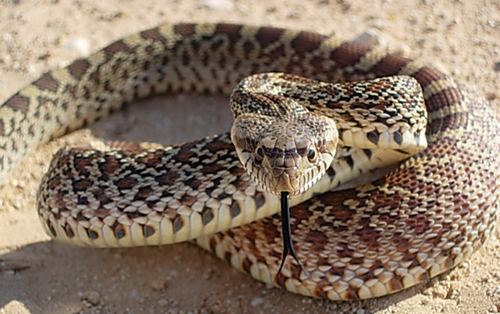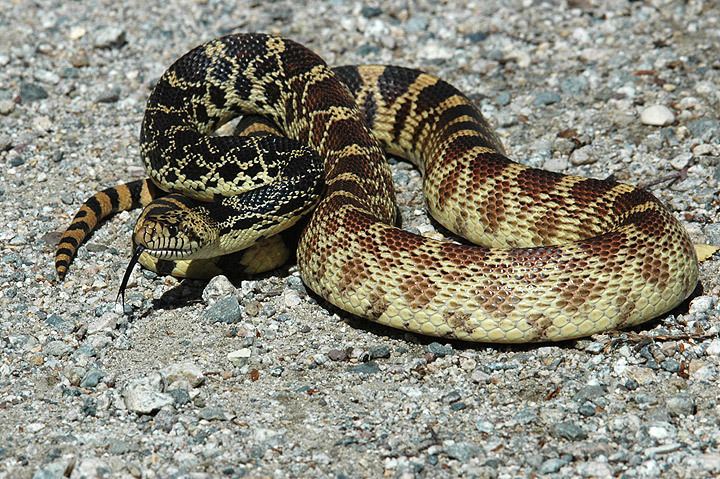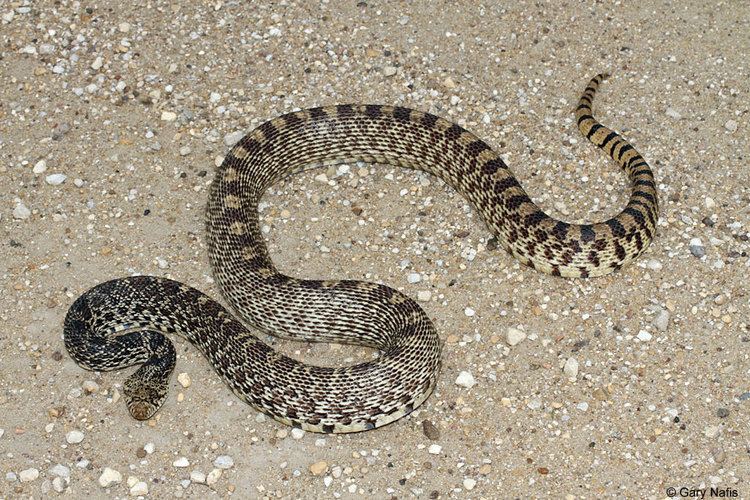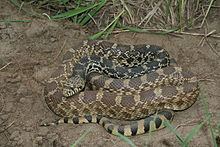Suborder Serpentes Subfamily Colubrinae Phylum Chordata Rank Subspecies | Subphylum Vertebrata Order Scaled reptiles Higher classification Pituophis catenifer | |
 | ||
Similar Snake, Pituophis, Pituophis catenifer, Reptile, Pacific gopher snake | ||
The bullsnake (Pituophis catenifer sayi ) is a large nonvenomous colubrid snake. It is currently considered a subspecies of the gopher snake (Pituophis catenifer).
Contents

Bullsnake
Etymology

The subspecific name, sayi, is in honor of American naturalist Thomas Say.
Bullsnakes are endemic species of Mexico and there are called Cincuate, (/sentli/; Náhuatl: corn, /coatl/; Náhuatl: snake).
Geographic range

Bullsnakes can be found throughout central United States, central and northern Mexico, Saskatchewan, Alberta, and desert regions of British Columbia, Canada.
Description

Adult bullsnakes average about 4 to 6 feet (1.2 to 1.8 m) in total length, and specimens of up to 8 feet 4 inches (2.5 m) have been recorded. Adult specimens can have an average weight in the range of 1–1.5 kg (2.2–3.3 lb), though the heavier known specimens can attain 3.6–4.5 kg (7.9–9.9 lb), larger specimens being quite bulky for a colubrid snake. This makes the bullsnake among the largest snakes native to Canada and the United States, although it is generally not as long as indigo snakes nor as heavy or as large in diameter as rattlesnakes. They are usually yellow, with brown, white, black or sometimes reddish blotching. The blotching pattern is as follows: large blotches on top, three sets of spots on the sides, and bands of black on the tail. Many color variations have been found, including albinos and white varieties. A scale count is required to distinguish juvenile bullsnakes from other juvenile gopher snakes.
Diet
Bullsnakes are very powerful constrictors who eat small mammals, such as mice, voles, rats, pocket gophers, ground squirrels, and rabbits, as well as ground nesting birds, birds' eggs and lizards.They are also great climbers and will climb into trees and other structures to raid the nests (and birdhouses) of birds to eat the nestlings or sitting mother. One snake can eat 5 small birds within 15 minutes. Juvenile bullsnakes depend on small lizards, frogs, and baby mice. Bullsnakes kill their prey via constriction.
The idea that bullsnakes occasionally eat rattlesnakes is sometimes given as a reason for humans not to harm bullsnakes when encountering them in the wild, although a better reason is the bullsnake's role in controlling warm-blooded vermin such as rodents.
Behavior
Though some bullsnakes can be docile, and with some time become accustomed to handling, most bullsnakes are quite defensive and known for their perceived "bad attitude".
When bullsnakes detect live objects too big to be prey they seem to perceive the object as a predator and take defensive action. Their first action is to remain quiet, not moving. Then when they feel they are able to move away from the object their next line of defensive is to move away as quickly as possible. Bullsnakes, however, are not fast movers and often have to take other defensive actions. When threatened by anything as large as a human, a bullsnake's next defensive action is to rear up and make itself look as large as possible while at the same time hissing at the perceived threat. It typically then begins lunging and retreating at the same time in order to escape.
Bullsnakes are sometimes mistaken for rattlesnakes and killed. Owing to its coloration, dorsal pattern, and semi-keeled scalation, the bullsnake superficially resembles the western diamondback rattler (Crotalus atrox), which is also common within the same range. The bullsnake capitalizes on this similarity by performing an impressive rattlesnake impression when threatened. First, it hisses, or forcibly exhales through a glottis or extension of the windpipe. The end of the glottis is covered by a piece of cartilage known as the epiglottis which flaps back and forth when air is exhaled from the right lung producing a convincing rattling sound. It also adopts a rattlesnake-like "S-curve" body posture as though about to strike. It will commonly vibrate its tail rapidly in brush or leaves, and flatten its head to resemble the characteristic triangular shape of the rattlesnake. These defensive behaviors are meant to scare away threats, however, and not to sound an attack.
In contrast to rattlesnakes, which usually keep their tail elevated in order to sound the most efficient rattle, bullsnakes tend to keep their tail in contact with the ground, where it can be vibrated against something.
Reproduction
Bullsnakes breed in March or April (depending upon their location) and usually lay their eggs in April, May or June (again, depending upon when the snakes breed.) They lay on average a dozen eggs in sand or other protected areas and leave the eggs to incubate unprotected. Clutches of 5-22 eggs have been observed. The eggs are elliptical, leathery, rough, sticky, and up to 70 mm (2 3⁄4 in) long. The eggs typically hatch in August or September. Baby bullsnakes are 20–46 cm (7.9–18.1 in) at hatching. Their color is grayish until after their first shed.
